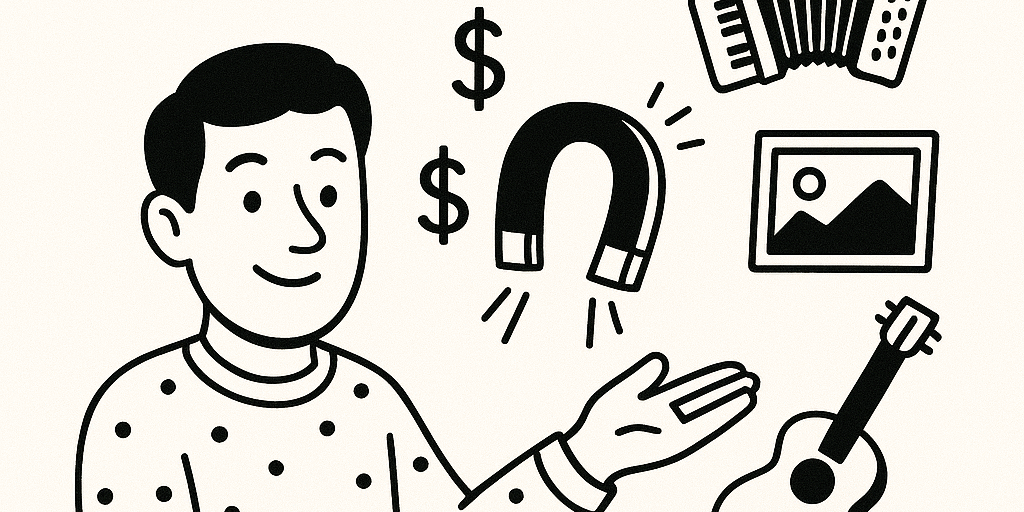Building relationships with estate sale companies, dealers, and collectors
Stop chasing consigners. Start attracting them.
After watching hundreds of auction operators struggle to fill their sales with quality items, I’ve noticed a pattern. The successful ones never seem to beg for consignments. Quality items just… find them.
Here’s their secret: they’ve built what I call a “Consignment Magnet”—a systematic approach that makes estate sale companies, dealers, and collectors actively seek them out.
Step 1: Become the “Safe Choice” Auctioneer
The Problem: Consigners are terrified of choosing the wrong auctioneer. They’ve heard horror stories of items selling for pennies, poor marketing, or unprofessional handling.
The Solution: Position yourself as the risk-free option.
What successful operators do:
- Create a “Track Record Portfolio”—screenshots of your top 20 hammer prices with before/after photos
- Offer a “Minimum Performance Guarantee”—if an item doesn’t meet a reasonable estimate, you cover the difference
- Develop a standardized intake process that feels professional (detailed photography, condition reports, estimated values)
Pro Tip from the Mastermind: One operator prints simple business cards with just his name, phone number, and “Guaranteed Professional Results.” He leaves them everywhere—estate sales, antique shops, even coffee shops. The word “Guaranteed” does all the heavy lifting.
Step 2: Build Your “Referral Engine”
The Reality: The best consignments come from people who’ve already worked with you successfully. But most operators treat each consignment as a one-off transaction.
The System: Turn every consigner into a referral source.
The Follow-Up Formula:
- Day of Sale: Send personal results summary with photos of their items selling
- Week 1: Ask for honest feedback (shows you care about improvement)
- Month 1: Send them a “Friends & Family” referral card worth $50 off their next consignment
- Month 3: Share success stories from recent sales (keeps you top-of-mind)
Advanced Move: Create a “Consigner Advisory Board”—your top 5 repeat consigners who get first access to preview upcoming sales and can provide feedback on new initiatives. They become your unofficial sales team.
Step 3: Become the Hub, Not the Hunter
The Shift: Instead of hunting for individual consignments, become the central hub where everyone in your market naturally gravitates.
How to Build Your Hub:
For Estate Sale Companies:
- Offer to handle their “problem pieces” (items too valuable for their typical clientele)
- Create a “Fast Track” service for time-sensitive estates
- Provide them with co-marketing opportunities (feature their services in your newsletters)
For Dealers:
- Host quarterly “Dealer Appreciation” preview events
- Offer trade-in credits for items that don’t sell in their shops
- Create a “Dealer Consignment Network” where they can refer clients directly
For Collectors:
- Become the go-to resource for market values (free verbal appraisals at shows)
- Host educational events: “What’s Your Collection Worth?” seminars
- Start a “Collection Legacy Program” for older collectors planning their estates
The Mastermind Secret: One operator sends a monthly “Market Report” to 200+ local dealers, estate sale companies, and collectors. It’s just 3 paragraphs about what’s selling well and market trends. This single email generates 40% of his consignments because he’s always top-of-mind when someone needs an auctioneer.
Your Next Action Step
Pick ONE relationship category (estate sale companies, dealers, or collectors) and implement the hub strategy for just that group over the next 30 days. Don’t try to do everything at once.
This Week’s Mastermind Challenge: Share in our group which category you’re targeting and your specific action plan. We’ll hold you accountable and share what’s working for other operators in your market.
The most successful auction operators understand this truth: great consignments don’t come from great sales pitches. They come from being the obvious choice when someone valuable needs to be sold.




